Today
we take the daily weather reports for granted and easily forget that
just at the beginning of the 19th century, during Goethe's lifetime,
one would never so much as have thought of a weather forecast based
on science. Not even the atmospheric variables permitting such a forecast
were known. It was just empiricism such as the knowledge of peasants,
shepherds and sailors that was available. Against this background the
cloud classification of Luke HOWARD (1772 -1864) shows its real importance.
With his work, "On the Modification of Clouds", this pharmacist
and apothecery from London, in 1803, laid the cornerstone for a classification
of clouds that, in its fundamental outlines, is still valid today. If
we speak of Goethe's meteorological observations we have to speak of
Luke Howard because it was he who coined Goethe's scientific view of
meteorology and his poetic reflections of meteorologic phenomena.
The Way
to the Poem "In Honour of Howard"
In an as simple as brilliant way Howard classified the clouds into four
basic forms according to the seperate vertical levels of the atmosphere.
Simple because these basic forms were subdivided phenomenologically; brilliant
because behind his considerations there was a sure feeling that the vertical
distribution follows certain physical laws.
Howard first
names the main cloud types: cirrus (feather cloud), cumulus (heap cloud)
and stratus (layer cloud) Furthermore, he identifies mixed type forms:
cirro cumulus, cirro stratus, cumulo stratus, and later, added cumulo
cirro stratus, also named nimbus, a rain cloud and a type of its own.
It has to be remarked, however, that his classification disregards the
mid-level clouds altocumulus and altostratus as well as the rain cloud
nimbostratus which reaches from low to mid-atmospheric levels. This, however,
does not belittle Howard's scientific achievements.
From Howard's
observations we can conclude that he attributed the different cloud types
to the different altitudes. The vertical structure of the atmosphere was
still rather unknown during his time. It was perceived from mountain climbing
that pressure and temperature decrease with height but the thermodynamic
context of pressure, temperature and humidity - and, thus, the origin
of cloud formation - was deciphered by scientists only later in the 19th
century.
Goethe correctly
recognized Howard's work as a breakthrough. It is well known that for
Goethe empiricism was the key to understanding nature. This explains his
enthusiasm for Howard's classification that, for the first time, gave
an empirically founded systematization of the clouds. Consequently, he
dedicated his poem "In Honour of Howard" (1821) to him:
"But Howard gives us with his clearer mind
The gain of lessons new to all mankind;
That which no hand can reach, no hand can clasp,
He first has gain'd, first held with mental grasp.
Defin'd the doubtful, fix'd its limit-line,
And named it fitly. - Be the honour thine!"
(The
translation of Goethe's poems follows D.F.S. Scott, 1949)
Howard's
System, Seen as Physics
Howard's vertical structural level of the clouds is based on meteorological
facts. Together with the decrease of pressure with increasing height the
atmosphere is typically characterized by a negative vertical gradient
of temperature. Up to the lower stratosphere (which in our latitude is
around 10 to 12 kilometres high) temperature decreases with height. Clouds
consist of condensed water in the form of cloud droplets or water in cristalized
form, i.e. ice. Clouds with a water/ice combination also exist.
Cloud formation takes place when the temperature drops below a certain
value (the dew point temperature). The (invisible) water vapour then condenses
onto tiny particles in the air, the condensation nuclei - a visible cloud
is formed. Howard's classification of cirrus- (feather-) clouds, cumulus-
(heap-) clouds and stratus- (layer-) clouds refers exactly to the fact
that at temperatures lower than -35 °C every cloud consists completely
of ice, at temperatures higher than 12 °C completely of liquid water
(due to reasons of cloud physics, water in the free atmosphere does not
freeze abruptly at 0 °C). His great achievement was to analyze this
without founded knowledge of the atmophere's vertical structure during
his time.
In spite
of all progress in cloud physics and regardless of all the refinements
that is included in the systematics of the World Meteorological Organization
WMO, Howard's purely empirical observations are still valid today. Still
nowadays the multitude of clouds can only be described descriptively;
and over and over again it happens that the meteorologist on duty when
doing his 3-hourly observation work detects cloud forms that can hardly
be squeezed into the narrow pattern of meteorological service routines.
Goethe
as a Meteorologist, Howard as a Poet
Goethe in, 1815 learnt to know the work of Howard when he, as the Director
of the Institute for Arts and Science in the Duchy of Saxony-Weimar, was
active in founding a meteorological station on the Ettersberg hill near
Weimar. In 1822 he got in mail correspondence with Howard.
Comparing
Luke Howard's scientific description of the main cloud types with Goethe's
poetic description, the empirically precise scientist from England and
the poet from Germany are coequal.
Example stratus: Howard names this layer cloud shortly and precisely as
"a widely extended, continuous, horizontal sheet, increasing from
below."

Stratus (Cap de Rosiers, Canada, 27.07.1991,
13:05 LST, photo: F. Ossing)
Goethe portrays
the stratus cloud very poetically:
"When o'er the silent bosom of the sea
The cold mist hangs like a stretch'd canopy;
And the moon, mingling there her shadowy beams,
A spirit, fashioning other spirits seems;
We feel, in.moments pure and bright as this,
The joy of innocence, the thrill of bliss!"
Example
cumulus: Howard sketches this cloud clearly and briefly as "convex
or conical heaps, increasing upward from a horizontal base".
Once again, the real accomplishment lies in a short, but precise definition.
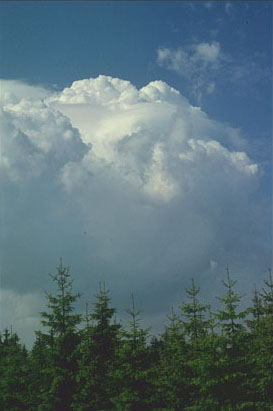
Cumulus (Sonneberg/Harz, Germany, 15.06.1974,
11:00 LST, photo: F. Ossing)
Goethe subtends
this with his poetical accomplishment:
"
... High as the clouds, in pomp and power arrayed,
Enshrined in strength, in majesty displayed;
All the soul's secret thoughts it seems to move,
Beneath it trembles, while it frowns above."
Example
cirrus: Howard describes this feather cloud as "parallel,
flexuous, or diverging fibres, extensible in any or in all directions",
a short definition that still today can cope with the standards of the
World Meteorological Organization.
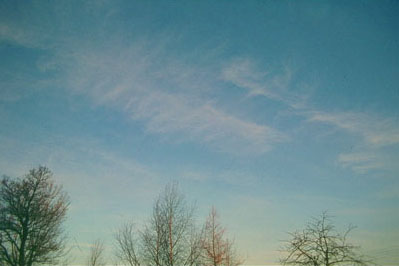
Cirrus (Coesfeld, Germany, 22.12.1974, 10:50
LST, photo: F. Ossing)
To Goethe
the cirrus appears in this way:
" … Then like a lamb whose silvery robes are shed,
The fleecy piles dissolved in dew drops spread;
Or gently waft to the realms of rest,
Find a sweet welcome in the Father's breast."
And finally
the example of the nimbus: here Howard's definition seems not to
be secure, this rain cloud could be a thunderstorm (cumulonimbus), a raining
cumulus cloud, or a layer cloud with precipitation: "Nimbus. The
rain cloud. A cloud or system of clouds from which rain is falling. It
is a horizontal sheet, above which the cirrus spreads, while the cumulus
enters it laterally and from beneath."

"Nimbus": does L. Howard mean nimbostratus
(Akkrum, Netherlands, 19.08.1981, 16:05 LST, photo: F. Ossing)
...
Goethe also
sees the rain falling from the nimbus but definitely refers to a thunderstorm:
"Now downwards by the world's attraction driven,
That tends to earth, which had upris'n to heaven;
Threatening in the mad thunder-cloud, as when
Fierce legions clash, and vanish from the plain; -"
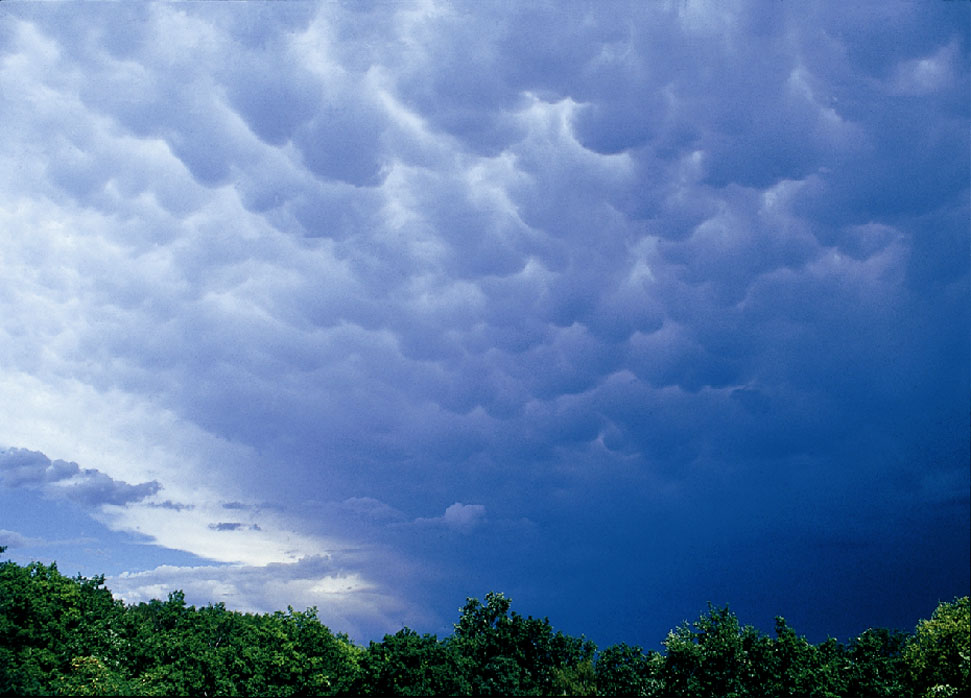
...or, like Goethe, the cumulonimbus (Potsdam,
17.08.2000, 14:50 LST, photo: F. Ossing)
?
Goethe,
by the way, reproduces the atmospheric water cycle in his "In Honour
of Howard": "As clouds ascend, are folded, scatter, fall…".
The atmospheric water vapour condenses to cloud droplets (here: stratus),
in cumulus clouds these cloud droplets rise up to the freezing level and
form snow crystals from which raindrops develop that fall to the ground.
In particular in thunderstorms (cumulonimbus) the upper part of the cloud
changes into cirrus (the "anvil" of a thundercloud). This water
cycle is also mentioned in Howard's paper.
It may be
remarked here that Goethe takes on clouds and other meteorological phenomena
not only in this poem but also frequently in his complete works. As an
example we recall here the vision of Dr. Faustus who in the clouds, "formlessly
huge and towering it hangs in far icy eastern hills", fancies
to recognize Helena (Faust II).
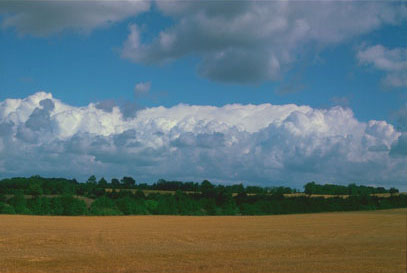
"... towering it hangs in far icy eastern
hills ", shower cloud with icy upper part (Neustadt i.H., 27.08.78,
12:30 Uhr, photo: F. Ossing)
Meteorological
Blur: Where is the Mid-level?
Already Schöne (1969, S. 29) alludes that Goethe uses the nomenclature
of Howard as a construction kit. Wherever he finds that Howard's systemization
has to be altered Goethe develops his own termini in which his understanding
of the atmosphere condenses.
This is consequent in so far as Howard's cloud classification in fact
inhibits some blurs.
Let us reconsider the above mentioned "nimbus" cloud. We have
seen that rain may fall from a thunderstorm, a cumulus or from a nimbostratus.
These three clouds belong to different atmospheric levels: the cumulus
is part of the low clouds, nimbostratus is a mid-level cloud, and the
cumulonimbus, a thunderstorm, vertically expands through all the three
levels. Howard accordingly calls the rain cloud a "nimbus or cumulo-cirro-stratus".
This meteorological unsharpness corresponds to a linguistical unpreciseness.
Modern meteorology defines low, mid-level and high clouds based on cloud
physical reasons: while - generally spoken - low clouds consist of cloud
droplets, high clouds are a conglomeration of ice crystals. Mid-level
clouds are a mixture of cloud droplets and ice.
Luke Howard could not have been aware of this physical background, his
pioneer work was exactly that he created a cloud classification that is
valid still today without this knowledge. On the other hand, however,
this results in a distinction between mid-level and high clouds that is
only diffuse. The mid-level altostratus as an individual cloud type is
not found, and under the category "cirro-cumulus" there are
subsumized altocumuli or even stratocumuli.

Altocumuls
skyl (Bay du Vin, New Brunswick, Canada, 30.07.91, 20:05 LST, photo:
F. Ossing)
This impreciseness
is reflected in a picture of "sheep cloud" that Goethe labelled
himself as "cirro-cumulus" (Goethe-Nationalmuseum Weimar, Inv.Nr.
1533). This picture definitely shows mid-level altocumuli with shading
in the clouds body, and not cirrocumuli that do not show such a shading.
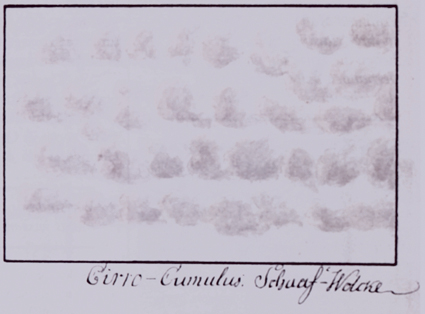
Altocumulus
clouds, named erroneously as "Cirro-Cumulus" by Gothe (1817,
pencil and Aquarell on paper, Goethe-Nationalmuseum Weimar, Inv.Nr. 1533)
What
is left:
As a Privy Council and Minister of the Duchy of Saxony-Weimar Goethe had
the arts and science under his direction. His weather theories, especially
his "Versuch einer Witterungslehre" (Attempt on a Weather Theory,
1825) today seem strange to us, when he tries to explain the weather-driving
forces of high and low pressure systems by the earth's body that breathes
the air in and out. Goethe as a theoretically erroneous theorist is opposed
by the weather practitioner Goethe. Under Goethe's supervision, starting
with the Weimar weather station that was established in 1815, a weather
observation network was installed as one of the first in Germany. The
records taken here can be understood as one of the roots of scientific
climatology and meteorology in Germany. Long before he learnt about Howard's
paper, Goethe engaged himself with the weather, drew cloud sketches and
measured temperature and pressure.
With the
acknowledgement of Howard's classification, however, an intensification
of Goethe's meteorological ideas takes place. It speaks in favour of Goethe's
self mockery when he puts himself on in a soliloquy:
"Disciple
of Howard, strangely
You look around and above you every morning
To see whether the mist falls or rises
And what clouds are showing."
- exactly, when in the morning we take a glance out of the window to see
if the weather forecast is right, "the mist falls or rises ",
before we leave the house. It may be true that nowadays and in our latitude
we no longer depend so much on weather conditions as did our ancestors
250 years ago. Yet weather is still an element of nature that touches
us directly every day.
References:
Goethe, J.W., "Schriften zur Naturwissenschaft", Reclam,
Stuttgart 1977
Luke Howard, :"On the Modification of Clouds", Original
in: Philosophical Magazine XVI, London 1803, Nachdruck in : Hellmann,
G., Neudrucke von Schriften und Karten über Meteorologie und Erdmagnetismus,
No. 3, Berlin 1894
Other Authors:
Hamblyn, R., "The Invention of Clouds: How an Amateur Meteorologist
Forged the Language of the Skies", London, Picador, 2001, pp. 256
Schöne, A., "Über Goethes Wolkenlehre", in: Jahrbuch
der Akademie der Wissenschaften in Göttingen für das Jahr 1968. Göttingen:
Vandenhoeck u. Ruprecht 1969, S. 26-48
Schönwiese, C.-D., "'Ein Angehäuftes, flockig löst sich's auf'
- Goethe und die Beobachtung der Wolken", in: Forschung Frankfurt.
Wissenschaftsmagazin der Johann Wolfgang Goethe-Universität Frankfurt
a.M., Nr. 2/1999, S. 12-18
Scott, D.F.S.: "Some English Correspondents of Goethe" Methuen,
London, 1949, pp. 51-54
Different contributions in:
Wehry, W. / Ossing, F., "Wolken - Malerei - Klima in Geschichte
und Gegenwart", Eigenverlag der Deutschen Meteorologischen Gesellschaft,
Berlin, 1997, 192 S. (German only)
Cloud classification:
WMO (World Meteorological Organization), "International Cloud
Atlas", Vol. II, Genf, 1987
A cloud
catalog including more than 50 photos and description is found here:
Neumann, N./ Ossing, F./ Zick, C.: "Wolken-Ge-Bilde",
("Cloud Scapes") CD-ROM, Deutsche Meteorologische Gesellschaft
1997, Berlin
Comprehensive information (in German) on Goethes work:
www.goethezeitportal.de/
Further
reading on arts and science is here:
'Arts
and Science' at GFZ.
|
![]() Franz Ossing; translation:
Mary Lavin-Zimmer, GFZ
Franz Ossing; translation:
Mary Lavin-Zimmer, GFZ 
